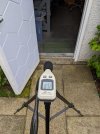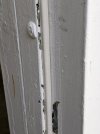I've lined my detached garage with insulation, OSB and plasterboard (drywall) to soundproof it and now I need to add seals to the door. The thin metal door did very little to stop sound and I've filled it with insulation, added two layers of solid wood and finally stuck on some thin acoustic tiles. It looks like this:

I have a bluetooth speaker I've been using as a ~100db noise source.

With the door open and the meter 1.2m from the doorway it's 87db with the door open.

67 db with the door shut so the door is absorbing/blocking ~20db as it is.

So what sort of strips are best for sealing this door? I've bought some 12mm batwing door strips and also some D shape foam and I intend to test before and after fitting. I think I can use both at once as I've made an extra edge on the inside of the door. So what will work best and how much difference could it make? The gaps are about 3 to 5mm all around.
I'm willing to buy other things to test out if the're not too expensive. Ideally if they have some science behind them. After all it's about audio science!

I have a bluetooth speaker I've been using as a ~100db noise source.

With the door open and the meter 1.2m from the doorway it's 87db with the door open.

67 db with the door shut so the door is absorbing/blocking ~20db as it is.

So what sort of strips are best for sealing this door? I've bought some 12mm batwing door strips and also some D shape foam and I intend to test before and after fitting. I think I can use both at once as I've made an extra edge on the inside of the door. So what will work best and how much difference could it make? The gaps are about 3 to 5mm all around.
I'm willing to buy other things to test out if the're not too expensive. Ideally if they have some science behind them. After all it's about audio science!
Last edited:









